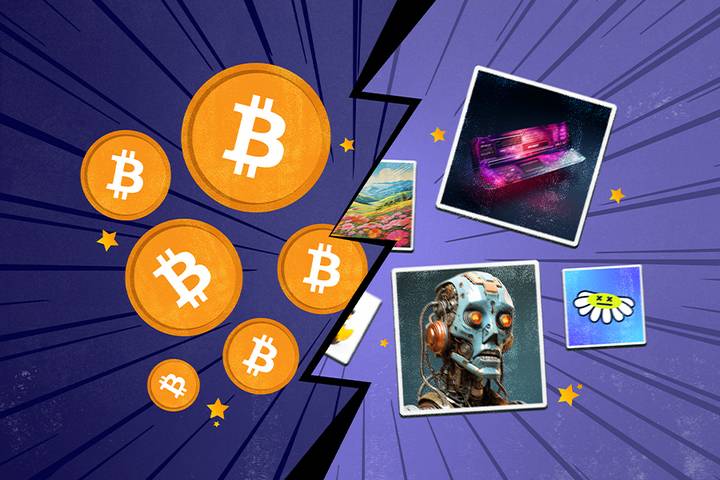If you’ve spent any time on the internet lately, you've probably heard about both NFTs and cryptocurrency. These two digital assets seem to be everywhere, from social media to news headlines. But what exactly are they, and how are they different? And, perhaps most importantly, which one is better? Let’s dive into the world of NFTs and cryptocurrency to unpack what each does—and why people are so excited about them.
What Are Cryptocurrencies, Exactly?
Cryptocurrency, or "crypto" for short, is a digital form of currency that relies on a technology called blockchain. Blockchain is essentially a secure, decentralized ledger that records all transactions made with a specific cryptocurrency. Bitcoin and Ethereum are two of the most popular examples of crypto.
Crypto is primarily used as money—it's a way for people to buy, sell, and invest without relying on banks or traditional financial institutions. Unlike traditional money, crypto isn’t controlled by any government or central authority, which appeals to people who want financial freedom and privacy.
So, What Are NFTs?
NFTs, or Non-Fungible Tokens, also use blockchain technology, but they serve a completely different purpose. While cryptocurrencies like Bitcoin are “fungible†(meaning each unit is identical and interchangeable), NFTs are unique. Think of NFTs as digital collectibles: they can represent anything from art, music, and video clips to virtual real estate and even memes.
Each NFT has its own value and identity, which is stored on the blockchain. When you buy an NFT, you’re essentially buying a one-of-a-kind digital item with proof of ownership. This concept has become popular among artists, musicians, and collectors because it allows them to create and sell unique digital works that cannot be duplicated or easily pirated.
The Key Differences Between NFTs and Crypto
The major difference between NFTs and cryptocurrencies is their “fungibility.†In the world of finance, fungibility refers to how interchangeable an item is with another. With cryptocurrency, each Bitcoin or Ethereum token is the same as any other—meaning you can swap them without losing value.
NFTs, however, are non-fungible, meaning each one is unique and cannot be exchanged on a one-to-one basis. Owning an NFT is like owning an original piece of artwork or a rare trading card: you know it’s unique, and so does everyone else.
What’s the Appeal of Crypto?
Cryptocurrencies have gained popularity for several reasons. They offer the potential for high returns, especially for those who got in early with Bitcoin or Ethereum. Crypto also provides a way for people to manage and invest their money without traditional banks. In countries with unstable economies, crypto has even become a way for people to secure their wealth against inflation and government interference.
Crypto is also practical; you can use it for more than just holding onto wealth. Many businesses now accept Bitcoin and other cryptos as payment, making it a useful currency for everyday transactions.
Why Are People Buying NFTs?
NFTs have a unique appeal. For one, they allow digital artists and creators to make money from their work in a way that wasn’t possible before. In the past, digital art was difficult to sell because it could be easily copied. But with NFTs, artists can sell unique pieces with verifiable ownership, just like traditional art.
Collectors also see NFTs as investments. Just like a rare comic book or a famous painting, a valuable NFT could potentially increase in value over time. While it’s a new market, some NFTs have sold for millions, sparking a lot of excitement among collectors and investors alike.
Which Is Better: NFTs or Crypto?
This is where things get interesting. Deciding whether NFTs or crypto is “better†depends on what you’re looking for.
If you’re interested in currency and investment: Crypto might be the better option. It’s designed to be used as money, and it has a more established market. Many people view crypto as “digital gold†because of its potential to increase in value over time.
If you’re into art, collectibles, or supporting creators: NFTs might be more appealing. NFTs provide a way to own digital art and rare items while supporting the artists who make them. They’re also great for collectors who enjoy owning unique digital pieces.
The Risks of NFTs and Crypto
Both NFTs and crypto have their risks, too. Cryptocurrency markets are highly volatile, meaning prices can rise or fall dramatically in short periods. This volatility makes it possible to earn big returns, but it also means you could lose money quickly.
NFTs are also risky because their value is tied to demand. Unlike crypto, which has a broader market, the value of an NFT depends on how much someone is willing to pay for it. If the market for a particular type of NFT dies down, the value of that NFT could drop significantly.
Final Thoughts: NFTs and Crypto Are Different, But Both Are Here to Stay
While they’re often talked about together, NFTs and crypto serve different purposes. Cryptocurrency is designed as a digital currency, whereas NFTs are digital assets that represent ownership of unique items. They both rely on blockchain technology, but beyond that, their goals and uses are quite different.
So, which is better? It really depends on your interests and goals. Whether you’re looking to invest, support artists, or just try something new, there’s a place for both NFTs and crypto in today’s digital landscape. And as these technologies continue to evolve, their uses and impact on our world will likely grow in ways we can’t yet imagine.


